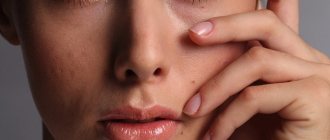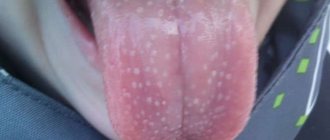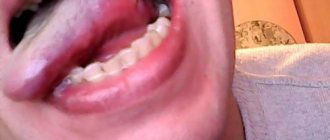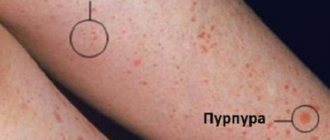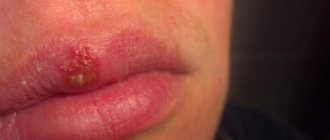People of any age experience blisters in the mouth. This problem causes considerable discomfort, interferes with the ability to fully chew food and causes pain throughout the entire oral cavity.
Experts name many reasons for this disease, ranging from improper care of gums or teeth to chronic pathologies of internal organs.
Regardless of the factors that provoked their formation, bubbles must be dealt with immediately and the most reliable and, most importantly, effective methods must be chosen for this.
Causes of blisters in the mouth
Blisters in the mouth can appear for various reasons.
Among the most important, doctors distinguish:
- Pathologies of the gastrointestinal tract.
- Diseases of the respiratory system.
It has been noted that every fourth patient with asthma experiences formations in the oral cavity.
- Problems with the thyroid gland.
A sharp decrease in immunity, in particular against the background of: infectious diseases; recovery from viral diseases; stress and changes in climate zones.
- Burns to the mucous membrane, for example, from hot drinks.
- Postponed chemotherapy.
- Constant overwork and sleep less than 7 hours a day.
- Mechanical damage to the oral mucosa, especially from dirty objects.
- Irregular brushing of teeth and tongue.
- Lack of vitamins in the body.
As doctors note, with an acute deficiency of vitamin C, various ulcers and blisters begin to appear in the oral cavity.
Possible causes of bubble formations
Various blisters in the mouth and lips signal the development of an internal disease or infection in the body. In some cases, such formations arise as a result of household damage.
The main reasons for the formation of bubbles:
- Burns. Their appearance most often occurs as a result of drinking hot drinks. In this condition, the oral mucosa first acquires a reddish tint, and then blisters form. Therapeutic methods include the use of anti-inflammatory gels and rinses.
- Herpetic stomatitis (see photo).
Herpetic stomatitisThis disease is of viral origin. It is accompanied by general malaise, fever, burning on the inside of the oral mucosa, red dots on the upper palate and the appearance of blisters. Treatment tactics depend on the type of virus.
- Dühring's dermatitis (herpetiformis). The disease is characterized by the appearance of blisters of various types and shapes on the palate and the inside of the cheeks. The pathology in most cases occurs in a chronic form, therefore it often recurs after the disappearance of the main symptoms.
- Pemphigus. A similar diagnosis is detected in childhood. Therapeutic measures are selected taking into account the form of the disease (simple or dystrophic), therefore they can be carried out in a course or performed when symptoms appear.
- Korsaki virus. The disease occurs in children under 5 years of age. After recovery, immunity to the virus is formed, so you cannot become infected with it again. Characteristic symptoms of the disease are small blisters on the legs, arms and mouth.
- Erythema. This disease is characterized by inflammation of the mucous membranes. In the acute phase, blisters, papules or vesicles appear, which cause not only malaise, fever, pain, but also make it difficult to eat.
- Diabetes. This disease is known to be accompanied by various unpleasant symptoms, including skin manifestations and formations in the oral cavity.
- Infectious diseases, including syphilis and scarlet fever.
- Damage to the surface of the mucous membrane by foreign objects during brushing, biting or other injuries. In such cases, a blood blister may appear.
- Diseases of the digestive system, blood vessels, heart.
- Hypovitaminosis.
- Response to chemotherapy.
- Immunodeficiency.
- Malignant formations.
- Kidney diseases.
- Disturbances in the functioning of the respiratory system.
- Pathologies of the thyroid gland.
- Metabolic disorders.
- Stress.
- Chronic fatigue.
Some of the reasons listed do not in themselves pose a danger to humans. Liquid accumulated in them is considered a threat because it contains bacteria or viruses.
Such pathogenic microorganisms, after spontaneous opening of the vesicles, penetrate into the resulting wounds and can lead to complications. To avoid such a situation, it is important to consult a doctor in a timely manner and select the appropriate treatment.
Video from Dr. Malysheva:
What do bubbles in the mouth look like, photos, symptoms
It is impossible to miss the appearance of blisters in the mouth.
In appearance they are formations:
- round, longitudinal or oval shape;
- white or transparent;
- with liquid inside.
Also, these formations may not be filled with liquid inside, but be hard to the touch.
Among the most important symptoms of this pathology, experts call:
- Pain in the mouth, especially when chewing food and drinking hot drinks.
- Constant or periodic burning sensation in a specific place.
In 97% of cases, the burning sensation intensifies when eating.
- Swelling of the tongue, cheek area or upper palate.
- Feeling of dryness in the mouth.
- Discomfort during conversations.
Some people experience periodic chills and also complain of a persistent body temperature in the region of 37.2 - 37.6 degrees.
Complications and prevention
Preventive measures are considered the best treatment for many diseases, as they reduce the risk of developing pathological processes.
These include the following recommendations:
- maintain oral hygiene;
- start treatment of diseases on time;
- wash your hands with soap;
- use a properly selected toothbrush so as not to injure the gums and mucous membranes;
- enrich the diet with vitamins.
Any formations in the mouth can signal serious health problems. If complications are present (fever, pain when swallowing, enlarged lymph nodes, etc.), you should visit a doctor within two days of their onset. Ignoring medical care can lead to the spread of inflammation to the subcutaneous tissues of the neck, lymph nodes of the lower jaw, and oropharynx.
First aid for blisters
When bubbles form in the mouth, a person requires first aid.
It is thanks to the simplest actions of the patient:
- the risk of further spread of blisters in the oral cavity will be reduced;
- there will be a milder course of the disease;
- formations will pass 2–3 times faster.
In general, doctors recommend the following as first aid:
- Rinse your mouth with clean boiled water.
- If you have a lip or tongue piercing, carefully remove the earring with clean hands.
- Take a sterile bandage, moisten it in the Chlorhexidine solution and apply it to the formations.
Also, in case of severe pain, you can take a painkiller tablet, for example, “Analgin”.
Important advice: as soon as a person sees the bubbles appearing, he needs to make an appointment with a dentist or therapist.
Treatment of neoplasm
Which method to treat a tumor that has formed in the oral cavity depends on many factors:
- seal size,
- view,
- localization,
- the reason that provoked the inflammation.
Initially, a piece of tumor tissue material taken is carefully examined in order to prescribe appropriate treatment, depending on its type and nature. It may include taking anti-inflammatory and antiseptic agents for treating the oral cavity, a course of medications and radiation therapy. The table presents therapeutic methods for combating tumors in the oral cavity for each specific type:
| Type of neoplasm | Treatment methods |
| Angioma |
READ ALSO: bone growth on the gum: causes of exostosis and ways to eliminate it |
| Pemphigus |
|
| Hemangioma |
|
| Myxoma |
|
Diagnostic methods
Only doctors can diagnose the nature and type of blisters formed. When they appear, a person needs to make an appointment with a dentist, therapist or infectious disease specialist.
In general, diagnostics are carried out according to the following algorithm:
- The doctor examines the oral cavity.
- Performs palpation of each formation.
- Clarifies with the patient all the symptoms and features of the course of the disease.
- Refers the patient for blood and urine tests.
Tests will show whether there is an inflammatory process in the body and will help with an accurate diagnosis.
In some cases, doctors refer the patient for a biopsy.
Treatment of blisters in the mouth
After making a diagnosis, specialists select a course of treatment.
In general it includes:
- Rinsing the mouth and local treatment of blisters with antiseptic agents, for example, Oxolinic ointment.
- Taking painkillers, in particular Analgin or Nise.
- A course of antiviral drugs, for example, Ergoferon (if required).
Also, for a complete recovery and elimination of formations in the mouth, it is necessary to remove the causes that provoke their appearance. For example, normalize hormonal levels in the body or treat existing pathologies of internal organs.
What to do if a bubble is detected?
If you notice a formation in the oral cavity, you must perform the following steps:
- Determine the external manifestations of the bubble.
- Remember the approximate time of its appearance.
- Suggest what the formation of education is connected with.
- Treat areas of the soft palate and folds of the mucous membrane where blisters have appeared with antiseptic agents. If there is a visible positive result, you should continue to perform these procedures. If such treatment is not effective, then you should not neglect medical help.
To determine treatment tactics, it is necessary to clarify the cause of the formations in the mouth. Dentists, therapists or dermatologists can make the correct diagnosis.
Specialists will interview the patient, examine any bubbles that have appeared, and prescribe laboratory tests. An experienced doctor is able to identify the disease even at the first consultation, and additional examination will only be needed to confirm the diagnosis.
Video from Dr. Malysheva about aphthous stomatitis:
Drug treatment
As a medical treatment, doctors prescribe:
- Antiviral tablets, in particular Hexoral. They kill viruses in the body, and also reduce inflammation and reduce pain.
- Means that accelerate healing, for example, rinsing with propolis tincture.
- Drugs that relieve pain symptoms, in particular, Lidocaine, Analgin, Nise.
Medicines that accelerate the healing of the mucous membrane, for example:
- applying Kalgel to the blisters, which relieves swelling, pain and redness;
- rinsing with Rotokan;
To rinse, you need to dilute one teaspoon of Rotokan in 80 milliliters of boiled water. The procedure must be repeated 3–4 times a day.
- application of "Oxolinic ointment".
This ointment is applied in the morning and evening to the affected areas of the mucous membrane. In 65% of cases, doctors prescribe vitamins, especially groups A and C.
Folk remedies
Some folk remedies are quite effective in eliminating blisters in the mouth.
They can be used if:
- the person has no contraindications;
- the doctor has approved this therapy;
- When using traditional methods, there is no worsening of the disease, increased pain symptoms or the appearance of additional formations in the oral cavity.
In general, some of the most effective folk remedies for blisters in the mouth are:
Applying aloe leaves.
Necessary:
- wash the aloe leaf;
- grind it to a mushy state;
- apply the resulting mass to the desired area of the mucosa;
- After 15 minutes, remove the pulp and rinse your mouth with boiled water.
Aloe leaves are applied in the morning and evening after meals.
Rinse with chamomile - St. John's wort infusion.
Required:
- take one teaspoon of dry chamomile and the same amount of St. John's wort;
- put in a glass;
- pour 250 milliliters of boiling water;
- cover everything with terry cloth;
- let sit for 35 minutes.
After the infusion, it is recommended to strain, cool to 40 degrees and rinse your mouth up to 4 – 6 times a day.
Rinsing with chamomile-St. John's wort infusion is carried out until complete recovery.
Applying cabbage-apple compress.
Necessary:
- take a quarter of a green apple and two leaves of white cabbage;
- chop everything;
It is better to grate the apple on a fine grater.
- spread the resulting mass onto the formations;
- leave for 10 – 15 minutes and remove.
Cabbage - apple compresses should be done 3 times a day.
What not to do?
If blisters appear on the oral mucosa, doctors warn that it is strictly forbidden to:
- try to squeeze out the formed blister, for example, with your hands or any improvised object;
- rinse your mouth with alcohol or solutions based on it;
- cauterize formations with iodine;
- pierce the bubbles, for example, with a needle;
- try to bite through the tumors with your teeth;
- touch blisters with dirty hands.
It is also prohibited to self-prescribe treatments and ignore doctor’s orders.
Treatment options
Therapy depends on the etiology of the bubbles and includes the following therapeutic measures:
- The use of antibacterial and disinfectants, antiseptics. The method is used to treat infectious blistering rashes. The drugs have a detrimental effect on the bacteria that cause the formations. Therapy often requires hospitalization.
- The use of drugs that have a local effect to treat injured areas. The products act as a preventive measure against the formation of new formations and eliminate existing elevations.
- Use of anesthetics.
- Treatment of the mucous membrane with a solution of furatsilin, manganese, soda, salt, aimed at local effects. They help eliminate the symptoms of developed inflammation and pain. Many solutions inhibit the activity of staphylococci and streptococci.
- Taking antiviral drugs if the cause of rashes in the mouth is associated with herpes activity. A combination treatment may be prescribed, including not only tablets, but also ointments.
Some patients prefer traditional methods, ignoring medical recommendations. This approach to the treatment of many diseases can lead to complications, since most pathological processes do not go away on their own and require drug therapy. Traditional recipes are recommended to be used in combination with pharmaceuticals, but after consultation with a doctor.
Popular home methods:
- Rinse your mouth with St. John's wort infusion. The procedure should be performed up to 5 times a day. To prepare the solution, you need to pour a tablespoon of dry St. John's wort into a liter of boiled water.
- Grind the aloe leaves to a paste. The resulting mixture should be applied to the affected areas for 2 minutes once a day.
- Mix apple and garlic juice in equal proportions, then boil it for 5 minutes and take 100 ml orally three times a day.
- Apply a chamomile compress to the affected areas 4 times a day.
- Treat the blisters several times a day with an ointment made from aloe juice, chopped cabbage leaves and egg whites.
You can read how to deal with herpes rash using traditional methods here.
Video from Dr. Komarovsky about herpes:
Formations that appear on the inner surface of the cheeks should be treated with caution. They may be filled with blood, so they cannot be injured.
Complications, preventive measures
Every person should know that blisters that appear in the mouth are fraught with a number of complications.
For example, people may experience:
- Oral diseases, in particular periodontal disease.
- Ulcers on the tongue, palate, inner lip or cheeks.
- Constant pain in the mouth, aggravated by chewing food.
- General weakness and body temperature 37.3 – 37.5 degrees.
To prevent any possible complications, doctors recommend adhering to preventive measures.
Experts advise:
- use dental floss after meals;
- do not forget to brush your teeth and tongue after sleep and in the evening;
- buy a new toothbrush every three months;
- Rinse your mouth 2–3 times a day with a special solution that kills bacteria;
- make sure that your diet includes fresh fruits and vegetables every day;
- walk every day;
- do not forget about moderate physical activity.
It is also recommended to see a dentist every 4 to 6 months and have all diseased teeth treated in a timely manner.
Blisters in the oral cavity occur for many reasons, ranging from poor hygiene to serious pathologies of internal organs. These formations need to be dealt with as soon as they appear in order to prevent various complications and further progression of the disease.
Blitz tips:
- never try to squeeze out bubbles or puncture them with improvised means;
- it is important to understand that if formations do not go away and cause great discomfort, then you should definitely visit a doctor;
- Always follow preventive measures and see your dentist regularly.
Reasons for the formation of a lump on the palate
A lump on the palate is a fairly common phenomenon in dentistry that occurs in both adults and children. Such a tumor can come out under the tongue, on the gums, cheeks or lips. Factors that increase the risk of tumors, cysts, blood growths, and blisters in the mouth include:
READ ALSO: yellow palate in the mouth in adults: causes and treatment
- smoking,
- excessive consumption of alcoholic beverages,
- mucosal injuries,
- dentures or crowns,
- poorly processed filling,
- viral infection,
- intrauterine disorders.
New growths are often the result of dental disease or other dental diseases. If you have a small ball or a bloody red lump in your mouth that hurts your teeth, hurts, or bleeds, this may also indicate the development of an oral tumor.
READ ALSO: the palate of the mouth hurts: causes, treatment and symptoms
Angioma in the oral cavity
An angioma is a vascular lump that is curled into a corkscrew on the palate. It is characterized by a bluish-violet or black-purple color. Blood or cavernous vessels, especially in the area where the lymph nodes are located, accumulate together, forming an angioma, and its growth gradually occurs. Most often it is removed surgically. Without timely treatment, such a tumor with severe bleeding typical of angiomas can lead to death due to blood loss.
Cyst of the mucous membrane of the palate
A cyst is a hard, rocky lump on the roof of your mouth that can reach several centimeters in diameter. Most often it can be found in the lower or upper part of the mouth. Its root cause is disturbances in the functioning of the sebaceous glands, which because of this are filled with secretions. Typically, cysts do not cause pain, but cause significant discomfort while talking or eating.
Blisters on the upper palate - epidermolysis
A hard white bubble on the roof of the mouth is another type of oral tumor. It is more common to see a bubble appear in the mouth in children. Formations of this kind are either a congenital disease or a consequence of caries. As they mature, they grow into large blisters and ulcers. Having reached a certain size, they burst, and intoxication of the body occurs. Epithelial cells also begin to exfoliate, water and protein balance are disturbed, and digestive problems arise.
READ ALSO: a bubble appeared in the mouth on the cheek: causes and treatment
Lumpy growth - myxoma
A myxoma can be described as a hard, white, bumpy growth that is a benign tumor. The usual location for myxoma is the hard palatal surface. Visual recognition of such a formation is quite a difficult task, therefore, to confirm the diagnosis, research is required, followed by analysis to determine the size and structure of the lump.
Other causes of bump formation
There are many other reasons that lead to the appearance of tubercles in the oral cavity. Among them are the most common:
- Fistula. A white lump forms on the gum with a hole through which pus comes out. Most often, a fistula is a complication after periodontitis.
- Exostosis. A pathology in which there are bony protrusions in the mouth.
- Epulis (more details in the article: fibrous and other types of epulis). The formation is a red ball on a stalk, resembling a mushroom. More common in women.
- Periodontitis. A dense lump appears on the gum as a result of pulpitis or an open dental canal (we recommend reading: lump on the gum near the tooth: causes and treatment).
- Hematoma. A watery tumor that can occur as a result of improper tooth extraction.
READ ALSO: lump on the gum after tooth extraction: how to treat it?
